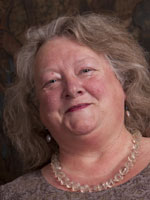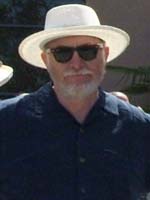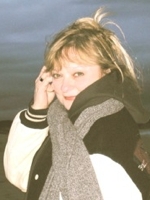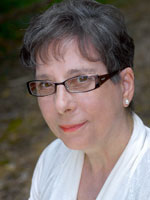Issue Number 2, February/March 2009
Contents
- DDT by Molly Fisk
- Just So by Martin Hickel
- Longing by Katy Entrekin
- On Ancient Wings by Andrena Zawinski
- The Desert in Bloom by Rina Ferrarelli
- The Robot Cowboy by Grace Marie Grafton
- Thirst by Paulann Petersen
- Tree by Jane Hirshfield
- Walking the Property (4 parts) by Grace Cavalieri
- Wilderness in the City by John Peterson
Archives: by Issue | by Author Name

DDT
by Molly Fisk
Molly lives in the south fork of the Yuba River's watershed, about 50 feet from Rush Creek, which does rush in winter but is dry in summer, helping her remember that seasons change, disappear, are reborn, and so are we.

The first fight I ever remember hearing as a child was at the dinner table when my father's parents were visiting us in San Francisco. They were arguing about the presidential race between Richard Nixon and John F. Kennedy, my parents for Kennedy and my grandparents for Nixon. I have no idea what was said, I think I was six, but grown-ups yelling at the dinner table made a big impression on me. From then on, I understood that my grandmother was something intractable called a Republican. My grandfather died soon after, but I was close to my grandmother for the next 30 years. She showed me that it's possible to change your mind.
After my grandfather died, my grandmother started doing what she loved to do, which was watching birds. She already had a banding license and had been monitoring the birds she banded and sending the data to Fish & Game. She lived on Cape Cod, but began driving her blue Volkswagen down the coast to Florida every autumn, netting and banding birds along the way, stopping in at wildlife reserves and Audubon stations and making friends.
When I was sent to visit her, she took me to walk the beaches, where it turned out she was tracking the use of DDT. I can't remember how DDT got into the ocean, but when seabirds eat fish with DDT in them, they hatch chicks who can't fly. My job was to look for feathers with very short shafts, and bring them to her, and then she'd send a big box of them to the scientists doing the study. When she found a malformed bird, which happened about once a week, she would send me up the beach ahead of her while she held it in her big hands, tightly, so it couldn't draw breath, and later made a study-skin of it and sent it to the Laboratory of Ornithology at Cornell.
Somewhere on this journey, my grandmother's ideas about the world shifted. She learned about ecology from all her biologist friends. She started reading Rachel Carson. The DDT study really made her mad. She taught me to rinse plastic bags and dry them on the dishtowel rack instead of throwing them away when I was ten, and she cooked out of Diet for a Small Planet before anyone I knew had even started to be vegetarian. The next time Nixon ran for president, she put a Eugene McCarthy sticker on her bumper.
I thought of her when I saw Al Gore's movie, "An Inconvenient Truth." Al says that unless we change the way we live in the next three to five years, we'll be in irreversible trouble. The change he's talking about feels daunting to me, and I already eat organic food, and turn off the water while I'm brushing my teeth.
The only thing that gives me a tiny bit of hope is remembering the way my grandmother changed. Even when overthrowing your most ingrained habits seems wildly unlikely, it's not impossible.
© Molly Fisk

Just So
by Martin Hickel
Martin lives between the watersheds of San Pablo Bay and Tomales-Drake Bay near the Pacific Coast.

we started out the same -- as children
there is no reason and no reason to expect change
look at you and me -- where was it anyway
we thought the wind would carry us
confused at birth we crashed the surf
baby boomed from strangers
whose eyes met swam together and quivered
there is much more water in this world
more urge than plan we fly to it -- fight the drift
both far and wide towards all kinds of loss
looking for what a place to land
a place to spend the night -- just so
the way each and every bubble of life
marries the air -- before bursting
© Martin Hickel
Longing
by Katy Entrekin

Green and chattering with night blown cold,
her longing leaves reach out
and off their branches toward my sill and light
then fall like seagulls swooping down,
upon the dark blue-brown of a planet bruised.
© Katy Entrekin

On Ancient Wings
by Andrena Zawinski
Andrena lives in Ballena Bay on Alameda, an island off the Oakland estuary in San Francisco Bay, where besides the regular stingrays floating by, an occasional seal wanders in under a boisterous Pacific Flyway.

The little black grackles keep coming back
for more.
They pick stale caramel corn from the sack,
swallow
them whole, toe-dancing snowdrifts, all bobs
in the delight
of the find. Even city doves wait their turn
in the blizzard
of birds, in the yes yes yes of it.
One flies
a warning, yellow-eyed at my face, as if
I would
rush her feathers for a spicy hat, her belly
for a bit
of meat to glaze, breast a bone from which
to pull a wish.
From where I stand behind the window glass,
it is only this
upon which I fix my eyes and my desire--
the wind
along lacy wing bars, early light that flirts
a wash
across the crown, sheen on bellies and bobs.
If these
blackbirds survive the cold another morning,
then so will I.
We have these things that hold us here,
this watch,
sweet feast, the voiceless scavenging--
the yes oh yes of it.
First published in Rockhurst Review, Vol 10
© Andrena Zawinski
The Desert in Bloom
by Rina Ferrarelli

Every year a little less water,
the struggle keener for the tough
desert plants, but today
the 15th of May, the desert is green,
greenest in the only green time,
dwarf pines and stunted junipers
glistening deep green, chirping loudly,
fluttering with small brown birds.
And all the big and small bushes
rise like bouquets of green
out of the sand, the reddish dirt,
the green of sage and Mormon's tea,
cactus and yucca, cliff rose
and rice grass, so many shades
of green, even the horse manure
dries green on the trails.
In the distance, the orange and white
rocks have sprouts of green,
and still green in Navajo memory
the sorrowful journey, the cruel wintering.
Smeared with red, the sharp-tipped grass
at the edge of the road.
First published in “Green Fuse”
© Rina Ferrarelli

The Robot Cowboy
by Grace Marie Grafton
Grace lives in the wooded hills of Oakland, California, in the Sausal Creek watershed. Outside her kitchen door is a second growth redwood tree, part of a landscape that was blanketed with old-growth redwoods at the time of the California gold rush, and a short walk east from her house is the wilderness area of Redwood Regional Park, where she loves to hike.

elected governor, mechanistic future,
every trim lawn wherever anyone
wants it but someone
sensible says, “A lot of mowing
must take place,” time
consumed by groceries and sanding
the paint bubbles, driving faster
not to give up fun while Nature
closes in: West Nile virus Ebola
in the rain forest Mont Blanc sliding
down its sides the ancient
Egyptian sun god burning
us to cancer we can’t venture
outside may as well live in
videos of what we always wanted,
looking into dark skies
where stars still burn.
© Grace Marie Grafton
Thirst
by Paulann Petersen

Your eyes must stay open
to the color of flowers.
Wherever their bright flash
catches your gaze, water flows.
You see rain
days after it stopped raining.
In your breath, you taste
the river running underground.
from A Bride of Narrow Escape, Cloudbank Books 2006
© Paulann Petersen

Tree
by Jane Hirshfield
Jane lives on the southeast hem of Mount Tamalpais in the San Francisco Bay Area, in the company of several second-growth redwoods. She can often be found doing volunteer mounted patrol beside Redwood Creek, which passes through Muir Woods before meeting the Pacific Ocean at Muir Beach--the southernmost stream in California in which coho salmon can still be found.

from Given Sugar, Given Salt, Harper Collins, 2001
It is foolish
to let a young redwood
grow next to a house.
Even in this
one lifetime
you will have to choose.
That great calm being,
this clutter of soup pots and books -
Already the branch-tips brush at the window.
Softly, calmly, immensity taps at your life.
© Jane Hirshfield

Walking the Property (4 parts)
by Grace Cavalieri
Grace lives and writes in Annapolis, Maryland, by the beautiful Chesapeake Bay, which is coming back to life with new fish, new hope, new streams.

I don’t know
what to say
about music
when I hear
the bluebird
crack grief
out of sound
like this.
**
The rain is not mine and it is not yours.
I walk in the woods as if the soul
could work here
but first I must give up even this leaf
as if it belonged to me
and also the wind
which once knew me
or sounded like it did.
Where do things go when we forget them –
That’s where we go too
following our names.
**
Smart spider, building a web
by the blue bug-light,
attracting his fair share
of what flies there.
**
The cows know when to come home at dinner time.
They always come home.
First published in Fieralinque
© Grace Cavalieri
Wilderness in the City
by John Peterson

As we look for a means of repairing the break between nature and culture, the psychic as well as the physical break, we eventually find ourselves up against a peculiar situation. We find that we must look for and learn to recognize wilderness inside that greatest bastion of our defense against the onslaught of nature—the city. This requires a different kind of approach, a different set of perceptions from those we are in the habit of employing. Natural oases in the city, such as Golden Gate, Balboa, or Central Park, though they are fundamentally important to our well being as inhabitants of cities, are not the solution. And the wildness of lawless gangs and pop music culture cannot generate the sense of the wild missing from our city lives. Rather we must change our internal way of being inside of cities. We can no longer accept city life cleaved off and alienated from the land out of which the city grew. Changing our perception of where we live has the capacity to change not only ourselves but our surroundings.
Some years ago I took on an extended exercise in changing perception while living in San Diego, a city that is set amongst carved canyons, mesas, and mostly dry river beds. Through foresight on the part of the community, much of the canyon land has remained intact and is off limits to development. And, through lack of foresight, heavy development occurred in the Mission Valley area around the mostly dry San Diego River, dry except in the few heavy winter storms when the river floods and creates havoc with the excessive development. I lived near Balboa Park and, while making a concerted and long-term effort to recognize the elements of nature and the wild, began to see and experience a very different city.
The city, I discovered, was full of wild creatures: possum, skunk, foxes, and, further out, coyote. The mildness of San Diego’s weather became a subtle barometer where even the smallest changes in temperature became cause for excitement. At the same time it was disconcerting to recognize areas where nothing remained of the natural landscape. In parts of the city nothing was visible except concrete, asphalt, buildings, cars and spits of planted grass and trees. Still, training perceptions to see nature and the wild was enlivening.
There is a longing in all of us, whatever our level of success, to return to the wild. We may purchase a cabin in the mountains, a house in the country, buy a boat to motor or sail the lakes or oceans. Apparently out of instinct, we seek to return to the land, to reconnect and be nurtured. And yet this deep need fulfillment is mostly unavailable to the economically modest or disadvantaged.
I worked at one time for the Forest Service in the Palomar Mountain area of San Diego County in a Youth Conservation Program and was both amazed and shocked to find 16-, 17-, and 18-year-old youths who had never been out of their city environment; some had never been off the few blocks around their homes.
It seems important that we find a way of experiencing the wild, the ultimate source of our being, no matter our economic condition.
To do this we will need to learn how to move our perception so that we are able to see the wild that is before us. We’ll need to find a way to bridge the gap between the city and the wild and to be with nature without fear, without romanticism, because this is a necessary condition of our well-being. We’ll need to relax our understanding of what constitutes the wild in order to appreciate the natural world that surrounds us even in the city.
We need to remember that cities are already in wilderness. There is soil under us, creeks that have been redirected under our feet. Cities have arisen in the heart of wilderness. This has always been so and it cannot be otherwise. In this sense, we are already in wilderness.
Some years ago in Fresno I lived in what was called a freeway house. It was one of the many homes that were bought up by Cal-Trans to be demolished for Highway 41, slated to be built in years to come. I lived with my family in a 1/4 mile wide stretch of open land that lay out in front of us for miles. It was a wilderness in the heart of a city. Left to its own wildness it was a haven for animals and birds, dogs and humans to run through. It brought to mind the forests of medieval Europe that were left as communal areas surrounded by villages, for all to use and enjoy. I so enjoyed the short time I lived in this free wild place.
Wilderness first off is a visceral thing, and we come to it when we remove the constructs of mind laid over our ancient visceral connections and move into a place very much known but very much shielded from our knowing because of centuries of conscious and then unconscious disconnecting.
Most of us, when first approaching the subject of wilderness, conjure up vast tracks of land without roads or dwellings, inhabited by wild, dangerous animals, lacking in the amenities to sustain our life and visited by the furious elements. Mostly these areas have contained things to fight against, tame, overcome, control, resist and civilize. The wild became the enemy of our safety, and cities became the bulwark against that which in the wild is overwhelming and dangerous. This disconnection was our way of winning the struggle for survival by shutting out the wilderness itself, and while this separation was necessary in our evolutionary survival, we have allowed it to lock us into a world where life is a constant struggle for existence.
Standing on a roadside next to the Kings River in the foothills of the Sierra, I saw a turkey vulture fly towards me low to the ground, maybe twenty feet high. After this great black bird with wide stretched wings and small red head flew by, I watched in awe as it did a complete barrel roll and continued to fly off into the setting sun.
I stood there looking over the lush green fields and I knew then that Winston Hibler, the voice of all those wonderful Disney nature films I remember seeing as a boy, was wrong. It is not about survival in the wilderness, it is about joy, playfulness, excitement and fun. These creatures live inside of the full complement of life, survival being only one element.
So while we are certainly facing an urgent need to save the natural world today, we must save ourselves and our connection to this natural world before we will have the impetus and the skills to save the trees, the air, the creatures. The first issue is saving our own lives, saving the cities and the land on which they stand, standing inside of the life that is here, trusting that life and rolling with it.
It is a question of who shapes the world that we experience. If we hold the mind open to experience wilderness in our bellies, in our hearts, we might just find the way to experience wilderness in our minds, here in the city.
We might begin to break down the mentally constructed barrier between city and wilderness and experience them both together, in the same place, here in the city that lies like a hollowed out place etched into the wilderness, connected by roots that reach deep into our past, deep into the lives of the living things around us.
© John Peterson